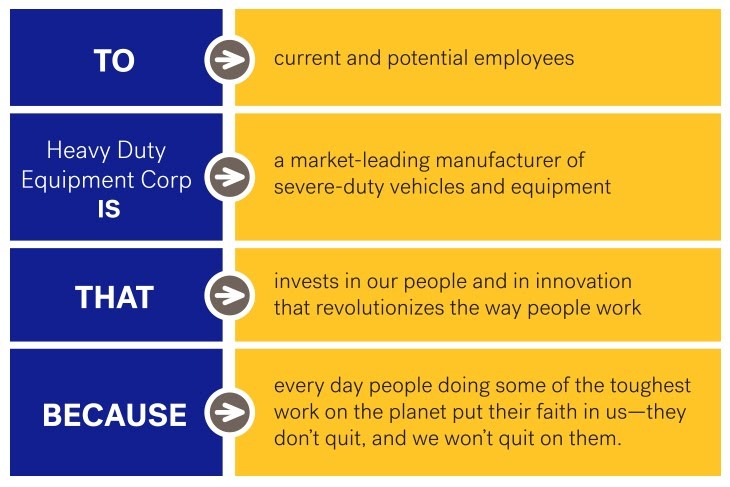We all know how tight the unemployment numbers have been (and continue to be), and with no immediate end in sight, it’s no surprise that it will continue to be a candidate-driven market. So employers have the choice to either:
- Stick with the status quo, or
- Be proactive in their efforts to drive better retention within their existing team and/or ramp up their recruitment efforts externally
But before you invest more money or time into improving employee retention, you need to ensure your brand message is expertly crafted and completely centered on what’s in it for employees. Doing so is vital to getting new recruits to stick. And your message can’t simply be that you offer a great salary, great benefits, and a great culture.
Candidates hear that from every other company clamoring for their attention.
Your message has to be more specific and tailored to what candidates’ needs and wants are. Here’s an example of an employer brand positioning statement for a made-up company:
Note the last field should be emotional. It needs to summarize WHY I would want to do business with the company or, in this case, work there. Not everyone will produce a product with a clear impact on people’s lives, but every organization exists for reasons bigger than simply “to make money.”
Find that reason. Plant a flag there, and then let everyone see it flying proud.
Now, let’s look at five benefits of retaining more employees:
- Unemployment is at a historic low. This just reinforces the fact that candidates are in the driver’s seat, which is all the more reason to make sure your employer brand is speaking about what matters most to them, not just the company.
- Turnover costs are not always visible, but they’re real. While we don’t pay an invoice for turnover, these costs can be significant. On average, a new hire costs 6–9 months of his or her salary. For someone making $40,000 a year, that is $20,000–$30,000 in lost revenue. That’s real money in wasted productivity and onboarding.
- Too much turnover can hurt culture and cause even more of an exodus. When disappointment, complacency, frustration, or disillusionment sets in, it can quickly spread through your ranks and cause a much larger issue for your company.
- With a focus on positioning your company as an employer of choice, you get the pick of the best candidates. And who doesn’t want that?
- Your best employees who are also engaged and satisfied will naturally recruit others who are a culture fit and top talent themselves. An automated pipeline of new, qualified talent to choose from!
On the other hand (and this might come as a shock), there are real downsides to too much employee retention. While most companies need more retention, it is the opposite problem that we all need to be aware of.
Just like Goldilocks said: “Not too much, not too little, but just right.”
Here are a couple of those negatives to keep in mind:
- Over-retention can encourage your poorest performers (and negative personalities) to stick around while your top performers funnel through a revolving exit door.
- People will be less open to the change needed to respond to the market, making you less competitive and more complacent of a culture you breed (unknowingly) and resulting in fewer workplace improvement initiatives and efficiencies and fewer innovative ideas.
So how do we improve our organizational employee retention? Here are a few employee retention strategies to help you keep your best workers longer:
- Start with strategy. Before you start implementing ideas to retain employees, you need to have a good understanding of why employees come to work for your company in the first place. This begins with employer branding. And it relies on the alignment of your HR and marketing departments to bring that employer brand to life and carry it out within your company and externally in the workforce marketplace.
- Plan for what success looks like. And measure it. What gets scheduled gets done. What gets measured gets improved upon. And don’t you want to make sure the money you are investing in this initiative is well spent?
- Be transparent during the hiring process, and hire for fit. Transparency during the hiring and onboarding process is key in finding and retaining the right kind of employees. Make sure you aren’t hiding or sugar-coating aspects of the company or the job just to get someone interested in the position.
Miles Anthony Smith, a digital marketer at Imaginasium, delivers solid content for people hungry for answers to their most vexing questions or challenges.

